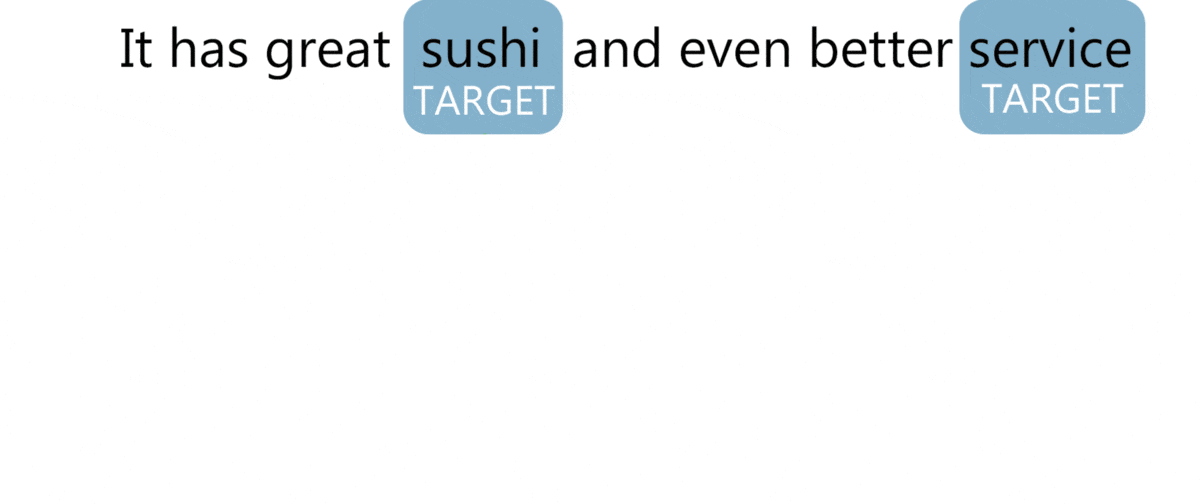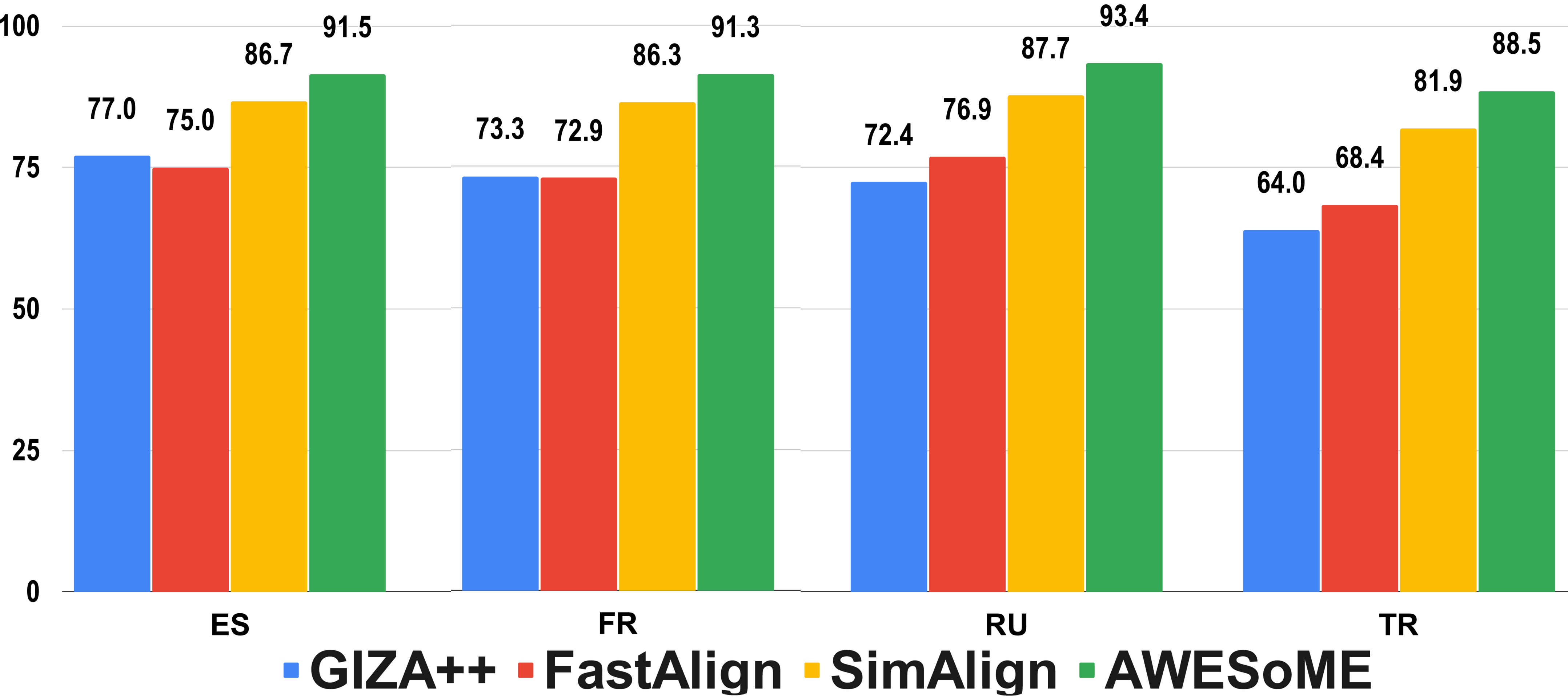Looking for our manually/automatically projected ABSA/CoNLL datasets? See data/
This repository contains the code to easily project labels from one dataset into another. You can automatically generate
datasets for languages for which you do not have any labelled data 🥳
We currently support:
For translating your dataset check out Easy-Translate!!!
If you use this software please cite
@inproceedings{garcia-ferrero-etal-2022-model,
title = "Model and Data Transfer for Cross-Lingual Sequence Labelling in Zero-Resource Settings",
author = "Garc{\'\i}a-Ferrero, Iker and
Agerri, Rodrigo and
Rigau, German",
booktitle = "Findings of the Association for Computational Linguistics: EMNLP 2022",
month = dec,
year = "2022",
address = "Abu Dhabi, United Arab Emirates",
publisher = "Association for Computational Linguistics",
url = "https://aclanthology.org/2022.findings-emnlp.478",
pages = "6403--6416",
}
Remember that you must also cite the corresponding paper for the word-alignment generation method you use.
This code requires:
Python 3.6 or higher
PyTorch
tqdm
You will need to install each of the alignment tools separately. You will find a README.md file in each of the folders with the instructions to install them. You don't need to install all of them, just the ones you want to use. I recommend using SimAlign or AWESOME. SimAlign is much faster than AWESOME, it doesn't require training. AWESOME requires finetuning (can take many hours) and a GPU with >8Gb VRAM , but it is more accurate.
If you use our software, please cite our paper and the alignments methods you use 😊
This is a sample projection run to test the system.
python3 annotation_projection.py \
--source_test sample/en.absa.test.tsv \
--target_test sample/en2es.absa.test.txt \
--source_augmentation sample/en.txt \
--target_augmentation sample/es.txt \
--output_dir sample/output/ \
--output_name en2es_absa_test \
--do_simalign
Source datasets in TSV format (see sample/en.absa.test.tsv for an example). Our code supports IOB/IOB2/BILOU encoding, but we have tested it mainly with IOB2, so we recommend using it. The three splits are optional, but you must provide at least one. We will not perform any validation in the dev set or evaluation in the test set. This is just a convenience for projecting datasets that have multiple splits (we automatically concatenate/split them).
--source_train /path/to/source_train.tsv
--source_dev /path/to/source_dev.tsv
--source_test /path/to/source_test.tsv
Target sentences in txt format, one per line (see sample/en2es.absa.test.txt for an example). The splits should be parallel (translations) to the corresponding one in the source split and in the same order. The splits should contain the same number of sentences that the corresponding source split. The splits are optional, but if you provide a source dataset, you must provide a corresponding target dataset.
--target_train /path/to/target_train.txt
--target_dev /path/to/target_dev.txt
--target_test /path/to/target_test.txt
The output directory is where the alignments (talp file) and projections (tsv file) will be saved.
The name of the files that will be created.
The output files will have the path: {output_dir}/{output_name}.{alignment_method}.{data_split}.[talp|tsv]
--output_dir /path/to/output/
--output_name en2es_absa
The alignment methods to use. The alignment method should be correctly installed/compiled to be used. See the README.md file inside each alignment method directory for more info about installation. You don't need to install all of them, just the ones you want to use. If the flag is provided, we will generate the alignments and projections for the corresponding alignment method. You can provide multiple alignment methods, at least one of them must be provided. If you want to modify the parameters of the alignment method, you should modify the "model_utils.py" file inside each alignment method directory.
--do_mgiza
--do_fastalign
--do_simalign
--do_awesome
If you use AWESoME you can provide two additional flags. "remove_awesome_model" will delete the pretrained AWESoME model from the output directory after the alignments are generated. You can also provide the "awesome_model_path" flag to specify the path to a pretrained AWESoME model, we will use this model instead of training a new one.
--remove_awesome_model
--awesome_model_path /path/to/awesome_model_dir
Your dataset may be too small to be used for training the alignment method. You can provide an extra parallel corpus as data augmentation for training the alignment method. We will use both, the provided tain/dev/test splits together with the augmented corpus to train the alignments. The augmentation corpus consists of two txt files (a sentence per line), and the source data augmentation dataset should be in the same language of the source dataset. The target data augmentation dataset should be in the same language of the target dataset. Both datasets should have the same number of sentences. See sample/en.txt and sample/es.txt for an example.
--source_augmentation /path/to/source_augmentation.txt
--target_augmentation /path/to/target_augmentation.txt
There are two hyperparameters that you can modify to tune the projection algorithm to your dataset.
Punctuation: By default we remove punctuation from the alignments to prevent projecting a word into a punctuation mark.
We do this because in the NER and ABSA datasets a punctuation is never annotated, but this may not be the case for other datasets.
If you want to allow labels in the source sentence to be projected into punctuation marks, set the --do_not_remove_puncs flag.
For example, If coffee is projected into café . we will remove the . from the alignment.
But we will not remove the . if the flag --do_not_remove_puncs is set.
Gaps in the alignments: If a label in the source sentence is split in two or more parts in the target sentence, we will
fill the gap considering the unlabelled words between the parts as labelled words with the same class if the gap
is equal or lower than "--fill_gap_size" words (by default 1). For example, if we project a label and we get the following labels:
O B-LOC I-LOC O I-LOC O O we will fill the gap and get O B-LOC I-LOC I-LOC I-LOC O O.
Use 1 if you are projecting named entities or labels with a small number of words.
Use a larger value for argumentation datasets and datasets in which long sentences are labeled.
--fill_gap_size 1 \
--do_not_remove_puncs
If you want to test different hyperparameters without computing the alignments again, you can use the
--use_existing_alignments flag. You must use the same --output_dir and --output_name as the previous run and the same
train, dev and test files.
If you only want to generate word alignments, you can use the "generate_alignments.py" script. This script has the same parameters as the "annotation_projection.py" script, but the source and target datasets should be in txt format (one sentence per line). The output will be a ".talp" file with the alignments.
python3 generate_alignments.py \
--source_test sample/en.txt \
--target_test sample/es.txt \
--output_dir sample/output/ \
--output_name en2es_absa_test \
--do_simalign





